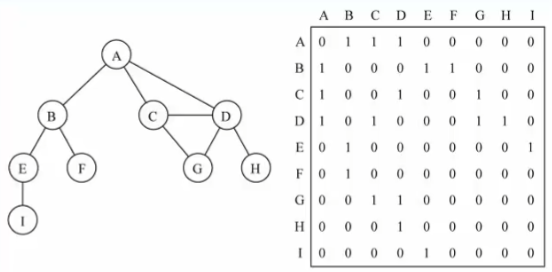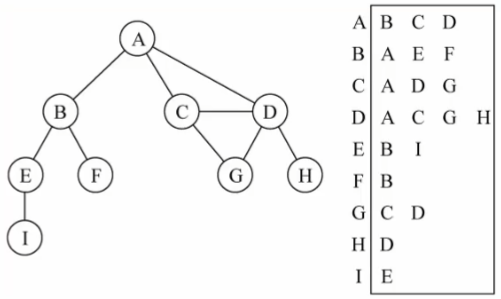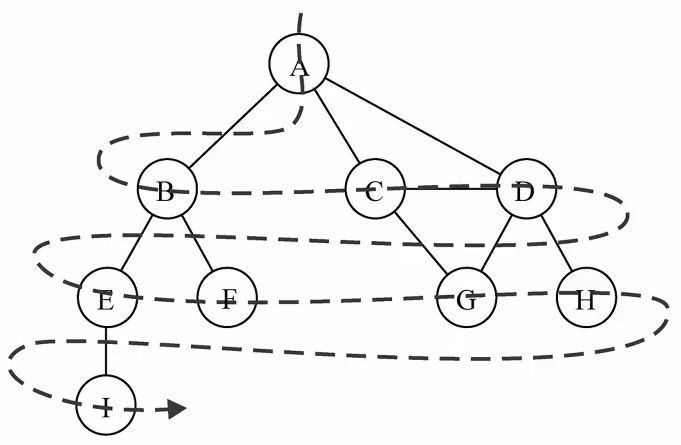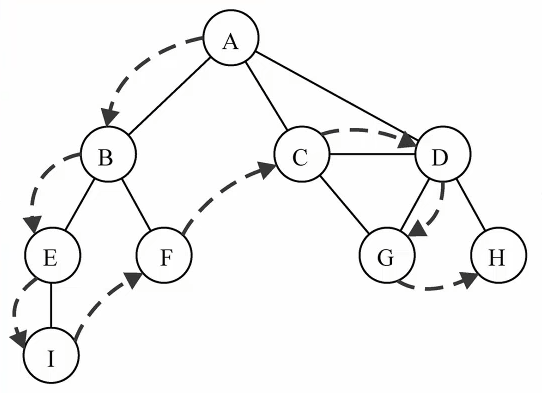图
约 899 字大约 3 分钟
2024-05-08
介绍
一组顶点:
- 通常用
V(Vertex) 表示顶点的集合
- 通常用
一组边:通常用
E(Edge) 表示边的集合- 边是顶点和顶点之间的连线
- 边可以是有向的,也可以是无向的
- 比如 A --- B,通常表示无向
- 比如 A --> B,通常表示有向
术语

顶点
- 顶点表示图中的一个节点.
- 比如地铁站中某个站/多个村庄中的某个村庄/互联网中的某台主机/人际关系中的人.
边
- 边表示顶点和顶点之间的连线.
- 比如地铁站中两个站点之间的直接连线,就是一个边.
- 注意:这里的边不要叫做路径,路径有其他的概念,后面会区分.
相邻顶点
- 由一条边连接在一起的顶点称为相邻顶点.
- 比如
0 - 1是相邻的,0 - 3是相邻的.0 - 2是不相邻的.
度
- 一个顶点的度是相邻顶点的数量
- 比如
0顶点和其他两个顶点相连,0顶点的度是2 - 比如
1顶点和其他四个顶点相连,1顶点的度是4
路径
- 路径是顶点
v1,v2...,vn的一个连续序列,比如上图中0 1 5 9就是一条路径. - 简单路径:简单路径要求不包含重复的顶点. 比如
0 1 5 9是一条简单路径. - 回路:第一个顶点和最后一个顶点相同的路径称为回路. 比如
0 1 5 6 3 0.
- 路径是顶点
无向图
- 上面的图就是一张无向图,因为所有的边都没有方向.
- 比如
0 - 1之间有边,那么说明这条边可以保证0 -> 1,也可以保证1 -> 0.
有向图
- 有向图表示的图中的边是有方向的.
- 比如
0 -> 1,不能保证一定可以1 -> 0,要根据方向来定.
无权图
- 如上图就是一张无权图,边没有携带权重.
- 上图中的边是没有任何意义的,不能说
0 - 1的边,比4 - 9的边更远或者用的时间更长.
带权图
- 带权图表示边有一定的权重
- 这里的权重可以是任意你希望表示的数据:比如距离或者花费的时间或者票价.
- 我们来看一张有向和带权的图:

表示方法
邻接矩阵

我们可以制定一个规则,0 表示他们没有链接,1 表示他们有链接
如果这里需要权重,那么 0 的意思不变,后面别的数字就可以是他们的权重
不过这种方法有些浪费空间,存在大量 0
邻接表

类似哈希表的存储方式
获取链接到了谁很容易,但是如果想需要获取谁链接了自己很难,可以使用逆邻接表
遍历方法
都需要指明第一个被访问的顶点
广度优先搜索 Breadth-First Search(BFS)
把当前节点的所有分支全部走一遍,然后再重新到分支的节点,把他的所有分支都再走一遍

深度优先搜索 Depth-First Search(DFS)
一条路走到底,走到底然后开始往回看,检查前面节点的别的分支是否都已经经过

TS 实现
namespace 图 {
class Dictionay<T> {
#values: { [key: string]: T } = {}
has(key: string) {
return this.#values.hasOwnProperty(key)
}
set(key: string, value: T) {
this.#values[key] = value
}
remove(key: string) {
if (!this.has(key)) return false
delete this.#values[key]
}
get(key: string) {
return this.has(key) ? this.#values[key] : undefined
}
keys() {
return Object.keys(this.#values)
}
values() {
return Object.values(this.#values)
}
size() {
return this.keys().length
}
clear() {
this.#values = {}
}
}
class Queue<T> {
#value: T[] = []
enqueue(element: T) {
return this.#value.push(element)
}
dequeue() {
return this.#value.shift()
}
front() {
return this.#value[0]
}
isEmpty() {
return this.#value.length === 0
}
size() {
return this.#value.length
}
toString() {
return this.#value.toString()
}
}
interface color {
[key: string]: 'white' | 'gray' | 'black'
}
type func = (value: string) => void
class Graph {
// 顶点
#vertexes: string[] = []
#edges: Dictionay<string[]> = new Dictionay()
constructor() {}
addVertex(vertex: string) {
if (this.#vertexes.includes(vertex)) return
this.#vertexes.push(vertex)
this.#edges.set(vertex, [])
}
addEdge(vertex1: string, vertex2: string) {
if (!this.#edges.has(vertex1) || !this.#edges.has(vertex2)) return
this.#edges.get(vertex1)!.push(vertex2)
this.#edges.get(vertex2)!.push(vertex1)
}
toString() {
return this.#vertexes.map((vertex) => `${vertex} => ${this.#edges.get(vertex)?.join(' ')}`).join('\n')
}
initColor(): color {
/**
* @description 白色: 没有被访问过
* @description 灰色: 被访问过,但没有完成探索
* @description 黑色: 被访问过,并且探索完成
*/
return this.#vertexes.reduce((previousValue, currentValue) => {
previousValue[currentValue] = 'white'
return previousValue
}, {})
}
// 广度优先搜索算法
BFS(initVertexes: string, func: func) {
const queue = new Queue<string>()
const color = this.initColor()
queue.enqueue(initVertexes)
while (!queue.isEmpty()) {
// 取出顶点
const currentVertex = queue.dequeue() as string
// 获取相连的其余顶点
const edges = this.#edges.get(currentVertex) as string[]
// 设置为灰色
color[initVertexes] = 'gray'
// 遍历所有边,添加到队列中
edges.forEach((edge) => {
// 如果是白色,则设置为灰色,并添加到队列中
// 如果是灰色,则跳过,因为已经被访问过了
if (color[edge] === 'white') {
color[edge] = 'gray'
queue.enqueue(edge)
}
})
func(currentVertex)
color[initVertexes] = 'black'
}
}
// 深度优先搜索算法(队列方法)
DFSQueue(initVertexes: string, func: func) {
const queue = new Queue<string>()
const color = this.initColor()
queue.enqueue(initVertexes)
while (!queue.isEmpty()) {
// 取出顶点
const currentVertex = queue.dequeue() as string
// 获取相连的其余顶点
const edges = this.#edges.get(currentVertex) as string[]
// 设置为灰色
color[initVertexes] = 'gray'
// 遍历所有边,添加到队列中
edges.forEach((edge) => {
// 如果是白色,则设置为灰色,并添加到队列中
if (color[edge] === 'white') {
color[edge] = 'gray'
queue.enqueue(edge)
}
})
func(currentVertex)
color[initVertexes] = 'black'
}
}
// 深度优先搜索算法(递归方法)
DFS(initVertexes: string, func: func) {
const color = this.initColor()
this.DFSVisit(initVertexes, color, func)
}
DFSVisit(vertexes: string, color: color, func: func) {
color[vertexes] = 'gray'
// 获取相连的其余顶点
const edges = this.#edges.get(vertexes) as string[]
// 设置为灰色
color[vertexes] = 'gray'
func(vertexes)
// 遍历所有边
edges.forEach((edge) => {
// 如果是白色,则设置为灰色,并开始递归调用
if (color[edge] === 'white') {
color[edge] = 'gray'
this.DFSVisit(edge, color, func)
}
})
color[vertexes] = 'black'
}
}
}